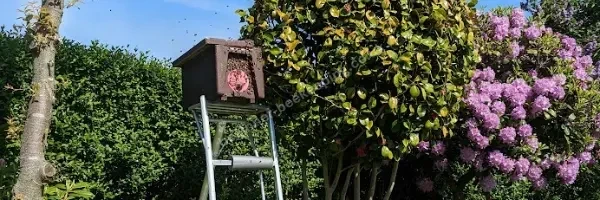How to prepare for safely collecting a swarm of honey bees
Collecting swarms is a vital aspect of beekeeping. To many members of the public, the sight of thousands of bees grouped together can be alarming. In reality, most swarms are calm and manageable – aggressive swarms are very rare.
Swarm removal is not only a public service but also a chance to raise awareness about bees and beekeeping. Many local beekeeping associations (BKAs) and national groups run voluntary swarm collection lists. However, these systems rely on fairness. Some people only join to acquire a single swarm, then stop responding – leaving extra work for committed beekeepers. This misuse creates unnecessary pressure and should be discouraged. The BBKA has a national swarm collector’s map. They also have this handy guide.
What Beekeepers Should Know Before Collecting a Swarm
Members of the public often have little understanding of what a “swarm” really is. Sometimes even a couple of bees are reported as one. To avoid confusion and ensure safety, anyone listed as a swarm collector should meet these basic requirements:
- Have sufficient experience to handle swarms safely without causing disruption.
- Be physically capable, as ladders and climbing may be necessary.
- Be properly insured, usually through BKA membership – check the conditions.
- Be able to identify whether the insects are truly honey bees, or an alternative such as wasps or bumblebees (Barnsley Beekeepers have a useful page to help the public).
Questions to Ask Before Attending
When taking a swarm call, gather as much detail as possible. At a minimum, ask:
- Has anyone else been contacted? (Multiple beekeepers may be called at once.)
- Take their phone number, give them yours, and ask to be updated if the swarm moves on.
- Get a description of the swarm to confirm it’s honey bees. A WhatsApp photo sent to you will make this job so mush easier.
- Where exactly are the bees? If access is impossible, a collection attempt may not be worthwhile.
- How high is the swarm? (Non-beekeepers often misjudge distances – compare with features like a window height or ask questions like can I access on a step ladder?)
- How long have the bees been there? Bees settled inside a building for several hours are much harder to remove.
Essential Equipment for Swarm Collection
If the situation looks manageable, bring suitable equipment, including:
- Standard beekeeping kit: hive tool, smoker, protective clothing. Bring spare protective gear for curious onlookers.
- A queen cage or queen clip.
- A suitable container – traditional straw skeps, wooden, or cardboard boxes work well (avoid plastic, as bees cannot grip the surface). A light PolyNuc often works well..
- Pruning tools such as a saw, secateurs, or loppers (only cut vegetation with permission).
- A cloth without holes and string (baler twine is ideal) to secure the container. A draw-string laundry bag is ideal to go around the nuc/box/skep.
After the Collection
Once the swarm has been secured:
- Thank the property owner for their cooperation.
- Ensure the area is left tidy with no damage caused.
If a fee is charged for collection, be aware this may be classed as commercial work – check that your insurance covers it. Reasonable expenses may be acceptable. BBKA insurance doesn’t allow you to charge for swarm collections.
